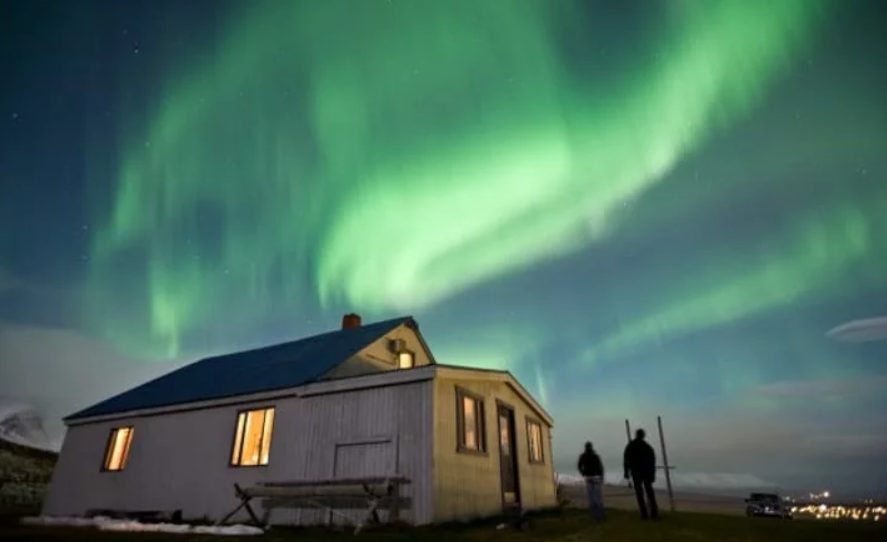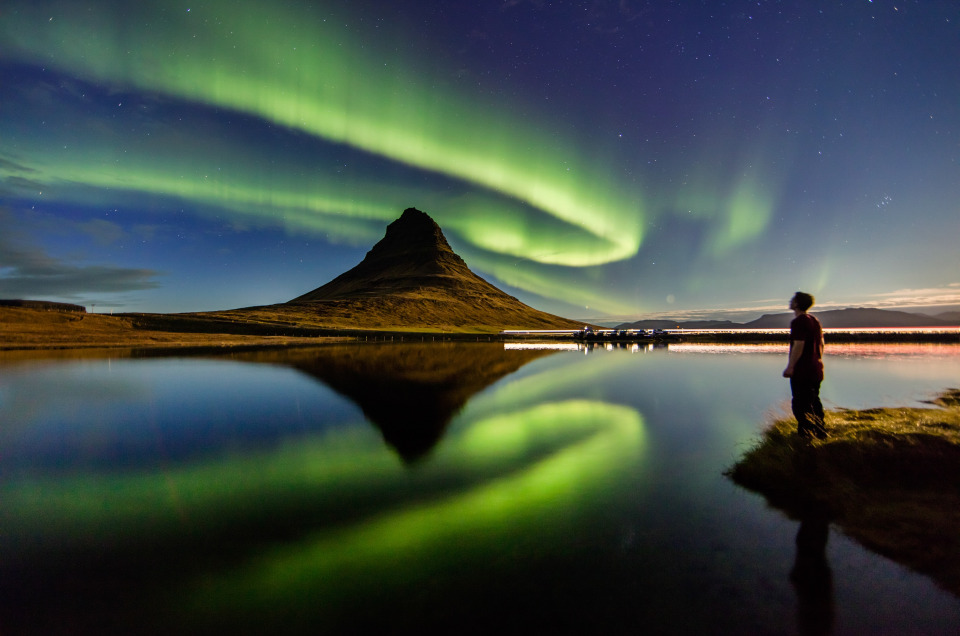The Northern Lights: A Mystical Celestial Display
The Northern Lights, scientifically known as the Aurora Borealis, are one of nature’s most captivating and mystical displays. This celestial phenomenon occurs when charged particles from the sun collide with gases in Earth’s atmosphere, creating beautiful, dancing lights in the night sky. The result is a stunning array of colors and shapes, often seen near the Earth’s polar regions.
As travelers and stargazers venture to experience the wonder of the Northern Lights, one question often arises: Can we see this enchanting spectacle from the vibrant city of Reykjavík, Iceland’s capital? In this blog, we’ll delve into the possibilities, challenges, and tips for catching a glimpse of the Northern Lights right from the Reykjavík city.

This picture was taken on September 14, 2023, in the backyard of one of our team members in Reykjavík.
The Science Behind the Aurora Borealis
To truly appreciate the possibility of witnessing the Northern Lights in Reykjavík, it’s essential to understand the science that fuels this ethereal spectacle. The Aurora Borealis is a result of a complex interplay between our planet and the sun. When the sun emits charged particles, particularly electrons and protons, they travel through space and can eventually reach Earth.
As these charged particles approach our planet, they interact with Earth’s magnetic field. Our planet has a magnetic field that extends from the interior and surrounds us, creating a protective shield against the solar wind. When the solar wind, carrying these charged particles, collides with our magnetic field, it gets deflected and funneled toward the polar regions.
In the polar regions, such as the Arctic Circle in the Northern Hemisphere, these charged particles are drawn toward the atmosphere. When they collide with gases in the atmosphere, primarily oxygen and nitrogen, they produce the breathtaking lights we know as the Northern Lights.
The Role of Geomagnetic Activity in Northern Lights Sightings
While understanding the science behind the Northern Lights is crucial, it’s equally important to consider the role of geomagnetic activity. Geomagnetic activity refers to the fluctuations and disturbances in Earth’s magnetic field caused by various factors, including solar activity and solar wind. The intensity and visibility of the Northern Lights are closely tied to geomagnetic activity. When geomagnetic activity is high, the Northern Lights become more active and visible at lower latitudes, potentially extending their reach to places like Reykjavík. However, when geomagnetic activity is low, the Northern Lights tend to stay closer to the polar regions, making them less likely to be seen in more southern locations. In essence, the Northern Lights’ visibility in Reykjavík and other places outside the polar circles hinges on the level of geomagnetic activity at any given time. Understanding this connection is vital for those hoping to catch a glimpse of this celestial wonder from Reykjavík city.
Can You See the Northern Lights in Reykjavík?
Indeed, the answer is a resounding YES! In fact, I had the incredible privilege of witnessing this awe-inspiring phenomenon right here in Reykjavík, an experience that has prompted me to create this blog and share some invaluable tips with you. One of the early signs that the Northern Lights might grace you with their presence is the weather and the skies in the morning. Keep an eye out when you wake up; if you’re greeted by clear skies and a sunny day, consider it a promising hint that the auroras might make an appearance in the evening. However, it’s essential to note that we’re specifically referring to the period from September to April for this celestial spectacle. Outside of this timeframe, the chances of catching the Northern Lights in Reykjavík are significantly diminished. So, timing is key to this luminous dance in the Icelandic night sky. I assume that many of you visiting Reykjavík will be staying in the downtown area. The closest place where you can escape some of the light pollution is the Sæbraut area along the seaside. Here, you might have better conditions for witnessing the Northern Lights
One of the primary challenges of viewing the Northern Lights in Reykjavík is light pollution. The city’s lights can obscure the delicate dance of colors in the night sky. This is why most aurora enthusiasts opt for Northern Lights Excursions into the countryside or remote areas with minimal light pollution for the best viewing experience. However, that doesn’t mean all hope is lost within the city limits. Reykjavík is not as densely lit as some other metropolises, and on nights of exceptional Northern Lights activity, it’s possible to catch a glimpse of the auroras, especially if you find a spot away from the brightest urban lights.
Some of the locations here would be a great option to see the northern lights: Grótta Light House, Hafravatn Area, Heiðmörk, and by the Sæbraut highway.
To improve your chances of spotting the Northern Lights in Reykjavík, consider the following:
Stay Updated: Keep an eye on Northern Lights forecasts, which provide information on geomagnetic activity levels. On nights of heightened activity, your chances of seeing the auroras increase. Check this website here.
City Periphery: Head to the outskirts of Reykjavík, away from the brightest lights, to reduce the impact of light pollution.
Clear Skies: Choose nights with clear, cloud-free skies, as clouds can obscure the Northern Lights.
Patience: Be patient and allow time for your eyes to adjust to the darkness. Sometimes, the Northern Lights appear faint at first but gradually intensify.
To sum it up, witnessing the Northern Lights in Reykjavík is indeed possible. While it comes with its challenges due to light pollution and weather conditions, it’s not an entirely rare occurrence, especially during the prime Northern Lights season from September to April.
As we conclude our exploration of Reykjavík’s Northern Lights potential, we invite you to embark on this captivating adventure. Whether you’re in the heart of the city or journeying into the outskirts, Reykjavík and its surrounding areas offer a unique opportunity to witness this celestial spectacle.
Now that you’re armed with knowledge about the possibilities of seeing the Northern Lights in Reykjavík, it’s time to plan your adventure. Don’t miss out on this mesmerizing experience; start making your travel arrangements today.
For those eager to delve deeper into the world of Northern Lights hunting, we’ve curated a selection of tours and resources to enhance your experience. Discover more about this natural wonder and how to make the most of your Northern Lights adventure in Reykjavík. Get ready to be enchanted by the dancing lights of the Aurora Borealis, right from the heart of Iceland’s vibrant capital city. Your Northern Lights journey begins here.





